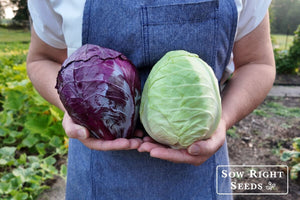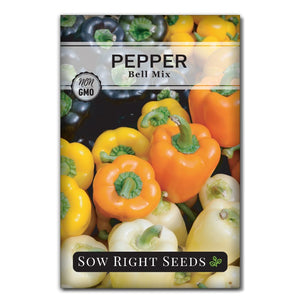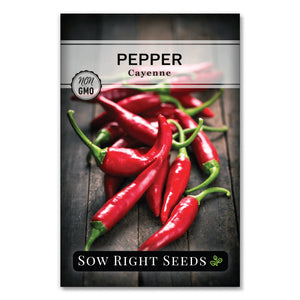Garden Like a Pro: Perfect Way to Start Growing Peppers from Seed
PeppersGrowing peppers from seed gives you access to a wide range of colors and flavors. Our pepper growing guide gives you easy step-by-step directions from indoor seed germination to successful transplanting and a bountiful harvest. Let’s get growing!

Peppers are a popular container vegetable, so even if you don’t have your own backyard garden, you can enjoy growing your own peppers on patios, balconies and other small spaces.
How to Grow Peppers from Seed
Peppers come in a range of colors, flavors, and heat. From sweet red bell peppers to white hot habanero, growing peppers from seed gives you access to a greater variety of peppers to choose from.
Usually, home and garden stores only carry a few of the best-selling varieties. With seeds, you’ll be able to choose and experiment for a lot less money. You’ll also know how the pepper has grown from seed to seedling and can be sure that your plants haven’t been neglected or mistreated.
The most important tip we give gardeners about growing peppers is that they're a warm-weather crop. They love a hot climate. It's crucial that peppers have lots of heat and sunshine.

Pepper Seed Germination Tips
Peppers are tropical, so they need very warm conditions to get started in life. In most growing zones you can start pepper seeds indoors 8 to 10 weeks before your last frost date.
You can direct sow pepper seeds in USDA zones 9 and 10 when the soil is warm. Use our Seed Starting Planner to enter your zip code for a personalized timeline.
Pepper seeds germinate at a balmy 75 to 90°F, so you’ll need a heat mat to keep them nice and toasty. Place the mat underneath to keep the soil very warm until they sprout. Once they have germinated, the seedlings will still need to be kept warm, so keep the soil at least 70°F.
Peppers need bright light overhead all day long. Use grow lights for indoor pepper plants. Lights should be placed close to the seedlings so that they don't grow leggy and fragile.
After true leaves appear, thin down to one seedling per cell or, if growing in a tray, one every two to three inches. This way, plants don’t have to compete for nutrients and have plenty of airflow.
Water seedlings from the bottom to avoid damping off.
Peppers love heat and light and this starts from the moment you plant the seeds.
- Start with moist seed starting mix in 3" pots or starter cells.
- Plant seeds 1/4" deep.
- Keep soil temperature between 75-85ºF.
- Seeds should germinate in 8-15 days.

Hardening Off Pepper Seedlings
At around 6-8 weeks, your pepper plants should be 4-5 inches tall. They should also have several sets of true leaves.
This is a good time to start hardening them off but only bring them outside when the temperature is warm enough. Don’t rush this step if the weather is cool or wet because your peppers will suffer.
Start with one hour a day and increase the time each day. Take 7 to 10 days to acclimate your pepper plants to outdoor conditions.
Nighttime temperatures need to be at least 50° F for peppers to thrive, with daytime temperatures around 70° or higher.

Transplanting Pepper Plants
When it’s time to transplant, take care to pick a bright, sunny area for them. Make sure it’s somewhere you didn’t use to grow peppers, tomatoes, eggplant, or potatoes the year before. All of these plants are nightshades and are vulnerable to the same diseases and pests.
Rotating to different spots gives those plants a better chance of survival.
Space plants 12 to 36" apart. Check your seed packet for variety specifics.
Bury plants to the same depth that they were already growing.

Growing Pepper Plants
With lots of heat, light, and rich soil, your pepper plants will reward you with a prolific harvest.
Sun
Give your pepper plants plenty of sunshine. These sun-loving plants appreciate 6 to 8 hours of sunshine every day.
Soil
Peppers need fertile, well-draining soil. A pH of 6.5 to 7 is ideal. Raised beds are a great place for growing peppers because the soil is usually warmer, loose, and drains well.
Water
Peppers have a high water content and will grow best with consistent watering. Water well. Especially during hot, dry weather. Unless you are growing hot peppers. The drought stress can result in hotter peppers. Water at the base of the plants to direct water to the roots and keep the leaves dry.
Fertilizing Pepper Plants
Pepper plants generally don't need a lot of fertilizer. When they start setting fruit, a balanced, organic fertilizer can be applied (5-5-5). A soil test can tell you if your soil needs additional nutrients for growing peppers.
Supports for Pepper Plants
I like to put supports around my pepper plants, especially the sweet peppers. The weight of the peppers and the midwest winds can easily damage the plant. The small tomato cages that are too fragile for beefsteak tomatoes work well for pepper plants. Our favorite DIY tomato cages are also excellent for pepper plants.
Place supports around the pepper plants when you transplant them outdoors. This will avoid damaging the roots later.

Harvesting Peppers
Green peppers can be harvested when the fruit is firm. It should feel heavy. Sweet peppers can be eaten when they are green, but they will be even sweeter if allowed to mature to their full color.
Harvest peppers often to keep the plant producing.
Pepper Plant Pests & Diseases
Pepper plants can be damaged by pests and diseases. Check often for aphids and other pests so you can manage them before they severely affect the pepper plants.
Sunscald will appear as a white spot. This occurs from too much sun in one place. Usually, this is because the plant leaves aren't giving enough cover.

Growing Peppers FAQs
Why did my pepper plant have flowers but no peppers?
When temperatures are below 60 or above 90ºF, this can affect the pollination of the flowers. Pepper plants can be pollinated by wind or insects. However, if the temperature is too cold or too hot, the flowers will drop before they are pollinated.
Why didn’t my pepper seeds germinate?
There are several reasons why pepper seeds may not germinate. One is that the pepper seeds were not viable. Make sure you purchase quality seeds with high germination rates. Another common reason for poor germination is not warm enough soil. Keep the soil moist but not soggy and the soil hot (80 to 90ºF). And the third reason is maybe the seeds needed more time. Some pepper seeds take longer to germinate. Check your seed packet for days to germination.
How long does it take to grow peppers from seed?
Sweet peppers take around 75 days to maturity. Hot peppers can take longer. Days to maturity refers to the time from transplanting. Keep that in mind when transplanting out into the garden so that you have enough warm days for a pepper harvest.
How do you grow peppers in pots?
Peppers are an excellent choice for growing in pots. First choose an appropriate sized container for the specific variety. Some pepper plants stay small, while others can grow to 3 feet tall. Transplant seedlings into a pot or direct sow seeds. Keep the soil from drying out completely, and add additional fertilizer every few weeks as the pepper plants grow.
And with that, you’re off to a great start growing peppers from seed. It won’t be long until you’re enjoying your own home-grown peppers. You’ll find they’re even more delicious when you pick them yourself that very day.
Written by Teresa Chandler and Beverly Laudie








Take a look at our hot peppers. You could try Hungarian Hot Wax, Anaheim, or Jalapeno for starters.
I want to grow medium hot long green peppers so where can I buy seeds for this kind of pappers
Leave a comment